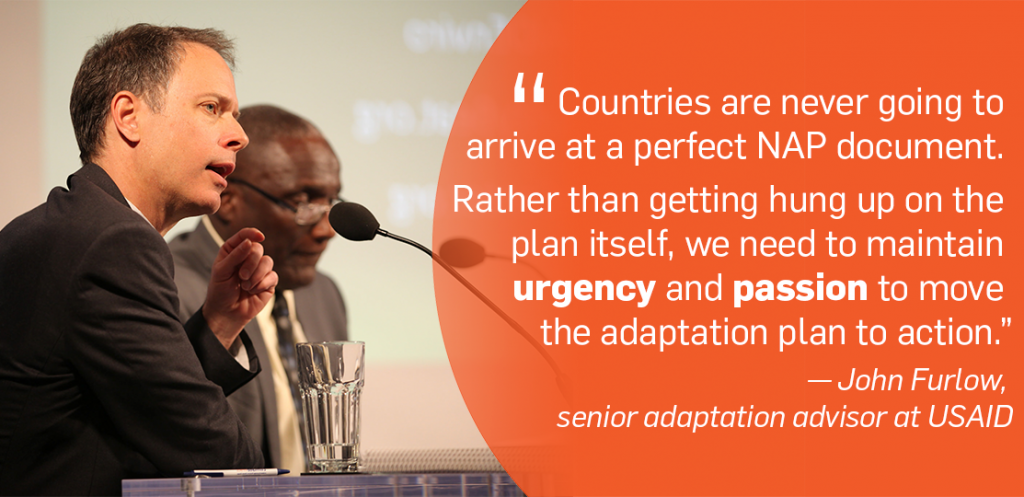This blog looks at a perspective on bilateral donor coordination in the NAP process based on remarks by John Furlow, Senior Adaptation Advisor with U.S. Agency for International Development (USAID), made during a recent webinar held by the NAP Global Network and other NAP Global Network workshops.
A key question that underpins why countries are engaging in National Adaptation Plan (NAP) processes is: what difference is this actually making to improve people’s everyday lives in vulnerable countries?

Planning and processes are often the focus of the United Nations and other international actors, while for vulnerable countries, the impacts of climate change are often localized and require very specific interventions—for example, managing floodwaters to protect homes.
“One of the most successful adaptation projects that I’ve seen implemented was our work with Jamaica’s meteorological service to develop a seasonal drought-forecasting information service,” said Furlow.
Jamaica faced severe droughts in 2014 and 2015 that caused an estimated USD 1 billion in losses for the country. Close to one fifth of Jamaica’s labour force works in the agriculture sector, and the droughts had an especially severe impact on Jamaican agriculture. But the impacts could have been even worse.
Using the drought-forecasting service that USAID helped develop, the meteorological service and extension service were able to warn farmers through “farmer field schools” and text messaging to prepare for low rainfall by, for instance, filling up water drums in anticipation of drought, enabling them to water their crops.
“Seeing the potential of—and then Jamaica’s success with—this drought-forecasting service, neighbouring countries in the Caribbean used a regional-scale version for things such as water rationing and health warnings,” explains Furlow. “This was an exciting example of how a climate change adaptation strategy that’s tested and shown to work in one country can be scaled up and used to help build climate resilience across multiple countries.”
Furlow continued, “The best-case scenario for an adaptation project—the reason why we do this work—is to make a tangible difference to make people less vulnerable to climate change risks in their everyday lives. But it’s also important to recognize that this success grew out of a national planning process that identified agriculture as important for Jamaica’s growth and jobs, and drought as a problem that hurt farmers.”
The NAP process is designed to scale up such national planning to foster greater coordination among different economic sectors and actors. It is an opportunity for countries to identify what’s driving development, how they are most vulnerable, where they need climate change adaptation support most urgently and where development partners can help.
“Effective climate change adaptation planning looks at how different sectors are linked and how coordinated action can add up into a bigger whole,” said Furlow. “It’s a chance for countries to ask questions like, ‘How can our water authority or transportation sector support agriculture or tourism?’ ”
The NAP Global Network was created in part because of the recognition that many different bilateral donors were supporting countries to develop NAPs and learning lessons as they went. In some cases, they were learning the same lessons.
“By working together, we could learn those lessons once—from experience and from each other’s’ experiences, and not over and over again,” said Furlow.
As with Jamaica’s drought-forecasting service, many lessons related to the NAP process—for example, how to design a financing strategy, or monitoring and evaluation (M&E) indicators—are easily transferable from one country context to another. Donor coordination helps share those lessons.
“It’s been an honor to work with the German government—in particular, with GIZ—on the NAP Global Network,” said Furlow. “And we’re thrilled that a number of new bilateral donors including Canada, Austria, the Netherlands, Australia, France and the European Commission have all recently joined the Network to coordinate their NAP support.”

When the NAP Global Network was created, bilateral aid for adaptation and climate-sensitive sectors key to NAP processes was approximately triple the amount of multilateral aid available for adaptation. The international donor landscape has a wide variety of adaptation support programs on offer, and duplication is a hazard that donors hope to avoid.
“If bilateral donors work closely together, we can ensure our support complements one another’s programs and avoids duplication,” said Furlow. “If we know, for example, that Japan is supporting a country’s agriculture sector adaptation, USAID can look to support another priority sector identified in that country’s NAP, such as the water sector or the health sector.”
The NAP process is essential to providing the cross-sectoral perspective of a country’s adaptation needs. Through bilateral donors coordinating their programs to cover as many of the priority areas as possible, adaptation interventions can do more to improve vulnerable people’s quality of life and help build their resilience to climate change.
“From a bilateral donor perspective, a NAP that results from talking to many ministries and sectors about their urgent needs is incredibly valuable,” said Furlow. “It provides us with the marching orders for where to provide support, so we know where it’s needed most.”
But there is also a need to avoid planning for planning’s sake.
“Countries are never going to arrive at a perfect NAP document. Rather than getting hung up on the plan itself, we need to maintain urgency and passion to move the adaptation plan to action.”
Any opinions stated in this blog post are those of the author and do not necessarily reflect the policies or opinions of the NAP Global Network, its funders, or Network participants.
Interested in joining the Network as a participant? Find out more.
Related
Watch the first webinar in a series by the NAP Global Network that explored the question: How are countries ensuring climate-resilient planning in priority sectors? This webinar includes presentations by Dr. Orville Grey, Jamaica’s Ministry of Economic Growth and Job Creation, and John Furlow, USAID.